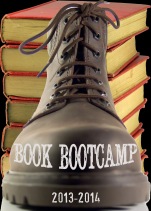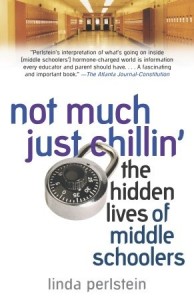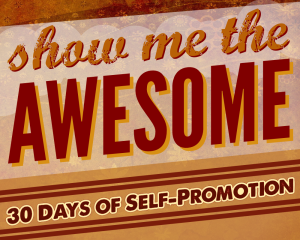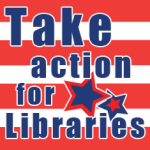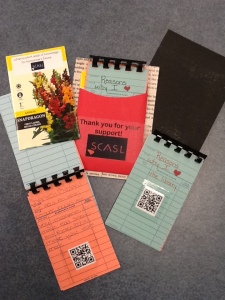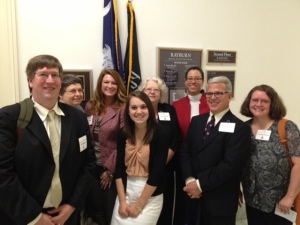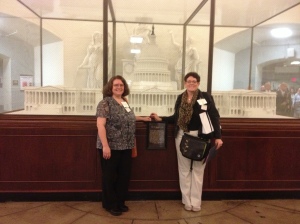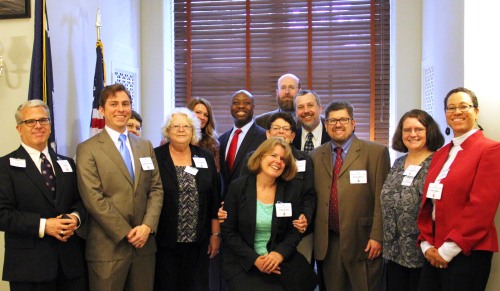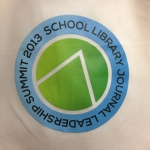
SLJ Summit 2013 Bag
This summer I received an invitation to attend the 2013 SLJ Leadership Summit. I honestly did not know such an event existed, and as I explored the possibility of attending, I became excited to discover that many of the “School Library Rock Stars” that I follow on Twitter and greatly admire would be in attendance. Then I began to wonder how I could get myself from South Carolina to Austin, TX. Fortunately, one of the benefits of being active in your state’s school library organization is that you make connections all over. I am presently the South Carolina Association of School Librarians Legislative Chair and last March I had the pleasure of traveling to Washington, DC with the director of our state library. I remembered her mentioning something about travel grants for librarians to attend conferences and e-mailed her an inquiry. I applied for and received a travel grant and eagerly anticipated September 27, 2013. At last that date arrived, I boarded my plane, and just a few hours later stepped onto Texas soil (pavement?).
Upon arrival, I immediately recognized my own species as I awaited the shuttle to my hotel. I mean, what do you think when you see a grown woman in a Hogwarts Express t-shirt and another with The Hunger Games peeking from her bag? I asked, “Are you ladies school librarians?” and I’m sure you can imagine the conversation that followed. I discovered that I had connected with a past president and the current president from the North Carolina Library Media Association. Not only that, these women were better prepared than I and had already discovered that the Austin Teen Book Festival was taking place right across from our hotel. Yes, I had died and gone to heaven.
Day One

ATBF 2013 Goodreads Shelf
Good fortune seemed to smile on me in Austin because I discovered after a little comparison of schedules that I had time to hear the keynote address at the Book Festival before the SLJ Summit began. Who, might you ask, did I have the honor of hearing? None other than Maggie Stiefvater! Squeeeee! Not only that, but there was a promise of at the very least seeing 40 other YA authors, not to mention the “swag” that several publishers and authors brought along to the festival. Maggie Stiefvater was a delightful and wonderfully entertaining keynote speaker. She was high energy and her stories gave me great insight into how she comes up with those twisted story lines that so delight our young adult readers (and me!). Her speech revolved around her writing and how those words came to be on the page. Somehow she has been labeled a “risk-taker”, but based on her story about somehow ending up owning a race car, actually racing that car, giving the car away and ending up with 2 silkie goats, and then permitting her fans (and one gang-banger) to tag her personal car at a book signing, I’m sure this is a false impression. Her imagination is surely a dark and scary place, but when she lets it take the reigns, we all benefit from her wonderful prose.
The SLJ Summit
Opening remarks by SLJ Executive Editor Kathy Ishizuka reminded the 200 or so attendees that libraries are a “world beyond scripted curricula and standardized tests” and asked us to think about how we cultivate interest in our students. Annie Murphy Paul, author of the soon-to-be-published Brilliant: The New Science of Smart, incredible thinker/research and frequent contributor to Time Magazine, then kicked off the Summit with a discussion of cognitive science and how important it is for us as educators to capture and hold our students’ attention if we expect them to perform and do well academically.
Some key points from Annie Murphy Paul’s lecture include:
- Make something more comprehensive by making it more interesting.
- We do not have to be “secret keepers” in education. Provide our students with a road map to learning. For example, if you are using a poem you know your students will not be able to decipher, give them the knowledge they need to do so. If you are studying a painting, give the students background about the artist so they can frame the artist’s perspective and interpret the art.
- Developing background in any subject will help us intrigue and capture the interest of our students.
- Demonstrate your own passion about a subject. If a student recognizes our personal interest, they may be able to connect as well.
- Avoid the “this is going to be important to your future” spiel that we are inclined to give because we don’t know why students need it other than it is on the test. Let students determine the importance of the learning and let them establish ways it may be important to them right here, right now.
- Help students develop a sense not only of why a subject or new knowledge matters to them personally but also the social value of the learning. If you have knowledge others need, want, or value then you have some authority over that subject. Who doesn’t want to be an expert? This is an ideal use of the jigsaw learning method.
- We, as educators, are “evokers of interest” and must help students build confidence and self efficacy, increasing autonomy and self direction. In an increasingly digital environment, this should not be news to any teacher, regardless of our title.
- It is “troublesome” that some schools, district, and educators are trapped in the “identify model” which assumes that only a few students are capable of higher order thinking, prompting us to spend all of our money and dedicate all of our resources to them, instead of doing our best to stimulate interest in all learners.
- There have been some studies that indicate use of digital devices for reading may not be as productive or successful as reading a printed book. Factors include not having “landmarks” of where something is on a page in a digital reader and a person’s ability to move from reading to so many other things like gaming and surfing the web. With print, all we can do is read. In a digital environment, we are constantly distracted by whether or not we should click on a hyperlink, answer a text, Google something we don’t know, and become lost in our new pursuits.
- While libraries are becoming more collaborative and social, we must still preserve some “sanctuary space” for those students who need quiet, security, and comfort. Students need a certain level of security and privacy, even in collaborative situations, to be able to speak their minds and share honest opinions without the fear of being overheard or berated.
- Cognitive science research has continually disproved our ability to “multitask.” We literally cannot pay attention to two things at once. Therefore, educators must “cultivate the practice of focusing on one thing at a time when it is time to learn, think deeply, write, and work.”
Following our wonderful keynote, we had a delicious lunch and then dove right into a panel discussion entitled “Allies in Leadership: Pivot Points & Opportunities for Teacher Librarians.” Featured panelists were Mark Ray, who was once a school library media specialist but has “crossed over” to the administrative side of education in his current role as Manger of Instructional Technology and Library Services in Vancouver Public Schools, and key players from that district including principal Kym Tyelyn-Carlson, curriculum coordinator Layne Curtis, and chief information officer Lisa Greseth. They discussed the changing roles of school library media centers and librarians, including opportunities afforded by Common Core to increase our leadership roles in our schools and districts, the digital shift and its effect on the 21st century classroom, organization of digital content, and flexible learning initiatives. Pivot points for our profession include our roles as technology integrators, content creation versus curation, and moving from a digital versus literacy mindset to one of digital AND literacy. My favorite learning moment was introduction to a new vocabulary word, “chopportunity”, which means taking a challenge and turning it into an opportunity. This, of course, should be a school library media specialist’s call to action.
Leadership Exchange
The panel flowed into breakout sessions where we were asked to explore the future of library media programs, library media centers, and library media specialists in 5 to 10 years. My main impression of this particular exercise was summed up when one of our participants stated there is simply no way to know where we’ll be or what library media programs will look like even in so near a future as five years. Look at all the changes that are currently taking place, changes that we anticipated to some degree, yet were largely unprepared for when they arrived. Advances in technology alone currently have the publishing industry, educational service providers, and even large corporations running to catch up with consumers and school districts who are embracing technology and parachuting into the digital landscape.
We did however have a few “ah-ha!” moments when Mark Ray, our facilitator, thew out a caveat as many of us focused too much on the limitations, challenges, and frustrations of the here and now and lost our future-focus. His asked, and I am sure I partially mis-quote, “What is sacred and what are you defending? The library or what happens there? What’s more important?” He went on to add that much of what we do in our libraries is “fluffy”, meaning it cannot easily be measured on a standardized test and may not generate the overwhelming mountains of data that administrators and other key players want to see. His challenge was to find ways to better link what we do to student report cards and achievement.
Storytelling in Transition
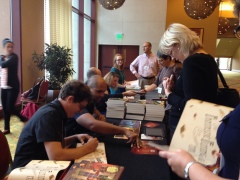
SLJ and authors treat us to Fantastic Flying Books, Chopsticks, and more!
Most of Saturday was filled with library media rock stars, but the closing session was reserved for the people most library media specialists truly love to hear and see: authors! These authors were doubly engaging however, because they included Lambert Fabian and Brandon Oldenburg from Moonbot Studios which created The Fantastic Flying Books of Mr. Morris Lessmore, author Jessica Anthony of Chopsticks fame, and publisher Ben Schrank. I was awed. Fortunately, they were so engaging and entertaining, I quickly moved from awe to major fan-dom. Again, I learned so much more than I thought possible and increased my vocabulary to include the definition of transmedia play as provided by Becky Herr-Stephenson, coauthor of the USC Annenbergy Innovation Lab study “T is for Transmedia.” What is transmedia? Social play, across media types. Herr-Stephenson then pointed out that libraries are perfect places for such play to occur, an environment that fosters tinkering, exploring, creating, and so much more. This of course segued into discussions of libraries as makerspaces for many people at the summit.
Fitting End to a Fantastic Saturday
I ended my day at the Teen Book Festival, where I met some of my favorite YA authors including Jo Knowles, Lauren Myracle, Sarah Dessen, and Melissa De La Cruz. It was incredibly awesome. I resorted to complete book-nerdom with wild abandon and had the best time talking to some of the young people who volunteered at the event. I also scored autographed copies of books by Holly Black, Jo Knowles, and Maggie Stiefvater.

View from Congress Avenue Bridge
Not one to waste opportunity, I followed the Teen Book Festival with a tour of the Pecan Festival then took a walk over to the Congress Avenue bridge to try to get a peek at the bats. Apparently there are about 1.5 million bats living under the bridge and they normally put on a grand display each evening. They decided they weren’t going to cooperate this particular night and instead spent most of their time darting in and out, snapping up insects.
Day Two
Antero Garcia, Assistant Professor of English at Colorado State University, opened our Sunday session. Word is he was only invited because he married a librarian, but he got us off to a great start by talking about his past experiences as an English teacher in South Central Los Angeles. His talked about how collaboration helps us build relationships and transform our schools and communities. Using methods such as “Ask Anansi“, he encouraged his students to go out and find the answers to questions that mattered to them and their community. He motivated students to investigate, interview people in the area, take photographs, and learn more about their own lives and their own stories. He then encouraged them to take the knowledge they gathered and share it to make a positive difference and inform those around them. He also gave us a bit of insight into everything from fan fiction to how authors use social media to market themselves. Why is this important? As Garcia points out, this shifts the relationship between the author and the consumer. This sparked ideas for many of us about how we market ourselves and our library programs. His final encouragement was for us to engage in and transform our world through our library programs.
ALA president Barbara Stripling told us that she considers herself a “lemonade maker” who sees opportunity in challenges. What are challenges for school library programs? Literacy, inquiry, social and emotional growth of students, equity and diversity. She reminded us that literacy empowers individuals to imagine, communicate, discover, and achieve. Barbara also encouraged us to sign the Declaration for Rights to Libraries, which I did. This was followed by 15 minute presentations from guests including YALSA’s Beth Yoke, public and school librarians, and Associate Superintendent of Lubbock TX IDS Joel Castro. Through this “Fast Learning” opportunity we overviewed several collaborative initiatives from coast to coast, and also had the opportunity to get an administrative view of library media programs. Mr. Castro encouraged us to make connections with our staff, particularly in the areas of math and science, where libraries and subject areas seldom meet, to be visible in our schools, take on leadership roles, and to gather hard data to share with our colleagues and our administrative teams.
I was forced to leave the summit a little early to catch a plane back to home, but I encourage anyone who has the opportunity to participate in the SLJ Leadership Summit or in other leadership opportunities to make every effort to do so. I learned so much, talked with and listened to some of the movers and shakers in our field, and came home still processing all I gleaned from the summit. To read what others have to say about the summit on Twitter, view #sljsummit.
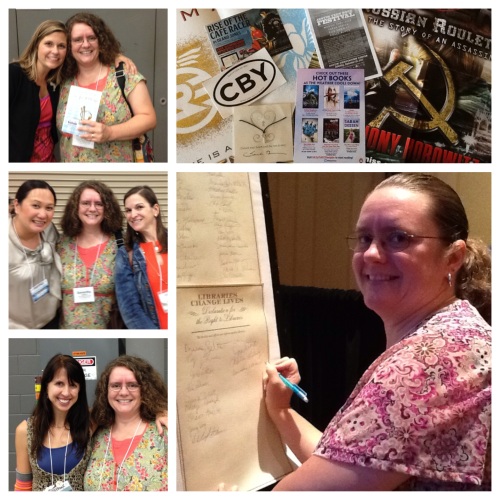
Clockwise from top: Jo Knowles, ATBF swag, signing the Declaration, Lauren Myracle, Melissa de la Cruz and Sarah Dessen
Useful Links
Transformation Through Effective Collaboration – SLJ Summit 2013
SLJ Summit Wordle
“T” is for Transmedia: Learning through Transmedia Play
Center for International Scholarship in School Libraries Study
 Witchtown by Cory Putman Oakes
Witchtown by Cory Putman Oakes


